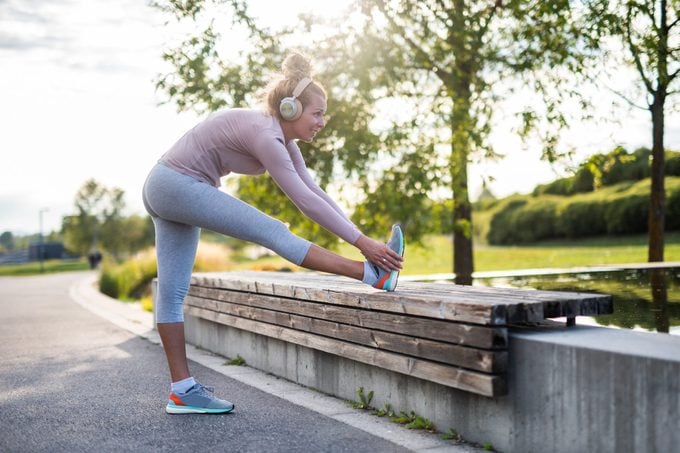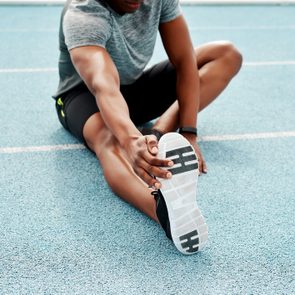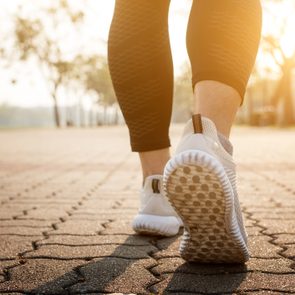6 Stretching Exercises to Balance Your Walking Routine
Updated: Nov. 09, 2021
Even if your walking routine doesn't leave you feeling sore or tight, you still need to incorporate leg stretches to ward off the exercise-related stress that can accumulate over time.
If you walk, you should try these leg stretches
Walking is one of the most accessible forms of exercise you can do to strengthen your heart and improve leg and core strength. And if you’re engaging in a regular walking routine, you might not even feel sore after each jaunt around the park.
If soreness is your only cue to stretch, you may not realize you should always include stretching as part of your walking routine.
“Walking can be more strenuous than you realize, especially if you’re distracted (in the best possible way) by enjoying the scenery or talking to a friend,” says Missy Berkowitz, a personal trainer and founder of Dig Your Deepest in Los Angeles, California.
“Just like any form of exercise, walking can leave your muscles tight, and a lack of stretching can lead to injuries,” Berkowitz says. “Stretching helps keep your joints loose and limber, reducing the likelihood of injury.”
Here are the best stretching exercises for legs that might benefit your walking routine.
(Learn what your average walking speed says about your health.)
What your stretching routine should focus on
You’re probably aware your walking routine largely focuses on the major muscle groups of your legs, including your glutes, hamstrings, quads, and calves.
It’s somewhat less obvious, but a walking routine also works your hip flexors, ankles, shins, feet, and even your core. Berkowitz suggests doing leg stretches as the bulk of your routine, but they shouldn’t be your only focus.
“Definitely incorporate stretches for other muscles you may not associate with walking,” she says.
“For instance, if you spend a lot of time sitting for work and notice your hips feel tight or your lower back hurts, you’re going to feel those aches even more when walking,” she says.
Muscles and joints connect, so when there’s an imbalance in one area, it’s common to feel it in other parts of our bodies, according to Berkowitz.
A well-balanced stretching routine can help prevent or reverse muscle imbalances (areas of tightness and weakness) you may be accruing throughout your day, whether as part of your everyday life or part of your walking routine.
And that’s one thing to keep in mind—walking primarily focuses on forward motion. In other words, you’re working all the muscles that help you move straight ahead, rather than the muscles that help you move side-to-side or in a twisting fashion.
This further emphasizes the need for stretching the leg muscles that assist with forward motion: primarily the calves, quads, hamstrings, and glutes.
(Learn all you need to know about walking for exercise.)
How to incorporate stretches into your walking routine
When and how you incorporate stretching into your walking routine may depend on your goals.
Generally speaking, before (or as part of) your walking routine, you should incorporate about five minutes of dynamic leg work to help get the blood flowing, prepare your body for the work of your walk, and warm-up. Then after your walk, allow for a few minutes of static (or stationary) stretches.
This before-and-after approach may seem like a lot, but it serves different purposes.
“I like to think of stretching before a workout as priming the body for the work ahead, but it’s just as important afterward to restore the body and relieve the tightness from exercise,” Berkowitz says.
“Not only can stretching relieve soreness or tightness, but it can be good for mental health. We carry so much of our stress as tension in our bodies—stretching helps relieve that.”
All in all, if you can carve out five minutes of pre-walking dynamic stretching and five minutes of post-walk static stretching, you’ll do your body good.
And Berkowitz suggests choosing stretches that target multiple muscle groups to help cut down on total time and get more “bang for your buck.”
(Fix the walking mistakes you didn’t know you were making.)

Leg stretches for your walking routine
Berkowitz suggests incorporating the following stretches into your walking routine. For dynamic stretches, perform two to three sets of 10 repetitions. For static stretches, hold each stretch for 20 to 30 seconds and repeat two to three times.
(Here are the leg stretches you should do before every workout.)
Downward dog
The downward dog stretch is popular in yoga, but it works just as well for athletes of all types, as the stretch works your calves as well as your shoulders and upper back.
Start in a pushup position on a mat with your palms under your shoulders, your body forming a straight line from heels to your head. Take a deep breath in, and as you exhale, press your glutes up toward the ceiling as you extend your arms from your shoulders until your body forms an upside-down “V.” Press through the balls of your feet and try to reach your heels toward the floor (although it’s fine if they never make it there!).
To perform the stretch as a passive stretch, simply hold the position, breathing deeply. With each exhale, try to deepen the stretch. To perform the stretch actively, “pedal” out your legs, bending one knee as you press your opposite heel closer to the floor, then switching sides. Hold each extension for about a second before making the switch. You should feel a good stretch in each calf as you alternate sides.
(Try these leg exercises at home.)
Forward leg swings
As the name suggests, leg swings are an active stretch. They’re great to incorporate at the beginning of your walking routine.
Stand next to a wall or a sturdy object for support. Place your right hand on the wall to perform swings with your left leg (and vice versa when working the other side). Your feet should be hip-distance apart, your core engaged, your body maintaining good posture.
Keeping your torso upright (the movement should focus on your lower body only, so your upper body should stay relatively stable), swing your left leg forward as far as you can, then backward as far as you can. Control the motion to warm up the hips. Perform 10 leg swings with the left leg before switching sides. Remember to perform two to three sets per side.
(Try these glute stretches to prevent pain in your back.)
Lateral leg swings
Another dynamic stretch, lateral leg swings, help balance and warm up the outside of the hips, which often become tight with walking.
Stand facing a wall or a sturdy object to use for support, your feet hip-distance apart, your core engaged. Place your hands lightly on the wall. Shift your weight slightly to the left side, removing the weight from your right leg.
Keeping your torso stable and upright, swing your right leg out to the right as far as you comfortably can, then swing it as far as you can to the left (crossing in front of your left leg). The movement should be steady and controlled. Perform 10 leg swings before switching sides, remembering to perform two to three sets per side.
(Loosen up your quads with these stretches.)
Standing hamstring stretch
The standing hamstring stretch is a great static stretch to perform after your walking routine.
Stand facing a bench or a sturdy chair, your feet hip-distance apart, your core engaged. If you need to, stand near a wall and place your hand on it for support and balance. Shift your weight to the left side and lift your right foot, placing your right heel on the bench, your knee extended and your toes pointing upward.
Keeping your core engaged and your torso tall, tip forward from the hip, extending your torso over your right leg until you feel a stretch along the back of your right hamstring. Hold the position for 20 to 30 seconds before switching sides. Remember to perform two to three sets per leg.
(Fix tight hips with a figure 4 stretch.)
Scorpion stretch
The scorpion stretch is an excellent multi-muscle group stretch that hits the lower back, hips, and glutes. You can perform this as a static or dynamic stretch, so try it before or after your walking routine (or both, if you’d like).
Lie on your belly on a mat, your arms extended out to the sides like a “T,” your chin resting on the mat (or lifted slightly off the mat).
Keeping your upper body fixed, bend your right knee until your knee forms a 90-degree angle, and then lift your right knee from the mat as you reach your right foot across your body as though trying to touch your right toes to the ground to the outside of your left leg. When you feel the stretch in your right hip and glute, hold the position.
For the static stretch, simply hold the stretch in place for 20 to 30 seconds before switching sides. Complete two to three sets per side.
For a dynamic stretch, hold the stretch for a second before returning your right leg to the floor and repeating to the opposite side. Perform 10 reps per side before resting, then perform two to three total sets.
(Learn more about the scorpion stretch.)
Bretzel
The bretzel stretch is an excellent static stretch that targets just about every major muscle group of the lower body, as well as the back and even the chest and shoulders. Berkowitz recommends the stretch to anyone short on time.
Lie on your right side on a mat, your knees bent at 90 degrees and stacked on top of each other, and your right arm stretched straight out in front of your chest, your palm flat on the floor. Lift your left leg and draw your knee forward, bending it at the hip as you reach your left arm back, grasping your right ankle with your left hand. Now lift your right arm, reaching your right hand to the outside of your left knee.
From here, exhale and relax into the stretch, allowing your shoulders to relax toward the mat as you press your left knee closer to the mat and draw your right ankle closer to your glute.
You should stop when you feel a good stretch in your right quad and hip flexor, although depending on your flexibility, you may also need to stop based on tightness in your low back, chest, or even your core. Hold for 20 to 30 seconds before switching sides. Perform two to three sets per side.
(Try a couch stretch to ease your hip pain.)





















